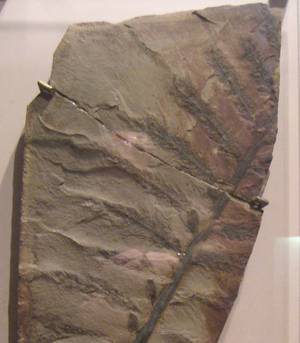Planet Earth Online - Fossil Forests
Interview with
Helen - When American scientists discovered some tree fossils in 2007, they turned out to be 385 million years old. That makes them among the world's oldest trees. But in order to identify these trees, they needed the help of fossil tree expert, Dr. Christopher Berry from Cardiff University. Well, Christopher travels the world - a very great job - searching for ancient tree and plant fossils, and analyses them back in his lab. Planet Earth podcast presenter, Sue Nelson joined him at the University's School of Earth and Ocean Sciences to see some of these fossils for herself.
Chris B. - So this is a palaeontology laboratory...
 Sue - Lovely squeaky door and is that a - I hope that's not a priceless fossil you're using as a doorstop there!
Sue - Lovely squeaky door and is that a - I hope that's not a priceless fossil you're using as a doorstop there!
Chris B. - That used to be a priceless fossil from Venezuela, but now, I've chopped the fossil off it, so it's just a block of rock.
Sue - Well let's see some of the blocks of rock that you've got here in your laboratory.
Chris B. - On the bench, we have some slabs of dark gray mudstone and on these slabs, we have some impressions and compressions of fossil trees. The compressions are the branches of these fossil trees.
Sue - It's not that easy to see though. I mean, you're saying that and I can see where the central one is, but it's harder to actually distinguish the bits you're looking for... Ah, now you've just picked up a jar of liquid here.
Chris B. - Yes. This is alcohol and one of the ways we can see these fossils better is just by simply pouring some of the liquid onto the fossil.
Sue - Oh, Yes...
Chris B. - And then you can see that the contrast between the fossil itself made out of carbon and the dark grey rock becomes enhanced.
Sue - You can actually see what looks like a very feathery frond branch, about the length of my finger. What plant was this and when was this plant on the Earth?
Chris B. - The name of the plant is Archaeopteris. It's technically called a progymnosperm but this simply means it's related to the living conifers and it was alive at the boundary between the middle and upper Devonian, and that means 485 million years ago.
Sue - So what can you learn from a large fossil like this?
Chris B. - What I'm particularly interested in is the morphology of the plant. That's to say its shape, its form and its size and these fossils are particularly important because they tell us a bit about the size of a tree. If we're interested in the impact of trees on the environment, the amount of carbon in a plant is probably one of the most important things, as well as the size of its rooting system.
Sue - Well let's move across your laboratory now to another bench table. We're next to a microscope. You've got a sequence of rocks that you've laid out for me. Each one imprinted with rather beautiful stems, branches of ancient plants.
Chris B. - Yes, these are more of the same type of plant. They're slightly younger. It is very similar in shape to a fern frond, but it's actually a branch of one of these early trees, and because it's a branch, it's much more woody. It would be much more stiff and not as floppy as a fern frond. But the structure is the same. You have a long central axis, little branches coming off the side and on each of that, forming a large sort of flattened structure. Then attached to those little branches are little leaves.
Sue - Moving along then, how does this differ because the rocks towards the right hand side are quite different in terms of their fossils because those look as though they have roundish or heart shaped leaves?
Chris B. - That's right. As we come up through time, the leaves of these plants become less wedge shaped and more full. They've got a margin which goes right around the outside with no incisions in it and the things become more flattened, if you like, more webbed and more photosynthetically efficient.
Sue - What importance is it in terms of the Earth today, knowing how our ancient forests were?
Chris B. - We know today that there's a tremendous difference between environments in which there are natural forests and environments today where those forests have been stripped away, and you're left with bare earth. Think of a rainforest. If you strip down the rainforest, then the soil that the trees have been growing in is very quickly washed away. There are very important things going on in the soils beneath the plants caused by the roots, the fungi and the roots, and the interaction of these roots with the minerals in which they're growing. These are very important processes. They not only control what the soil is like, but in fact, they actually draw down gases from the atmosphere, particularly carbon dioxide and take that carbon dioxide out of the atmosphere, and transport it away, so it's deposited as solid minerals within the sea. And this is an incredibly important process. We all know about the problems of carbon dioxide in the atmosphere today. This is one of the ways in which carbon dioxide is removed from the atmosphere in the past.
Helen - Fossil tree expert, Christopher Berry, explaining the importance of ancient trees to Planet Earth podcast presenter, Sue Nelson.









Comments
Add a comment